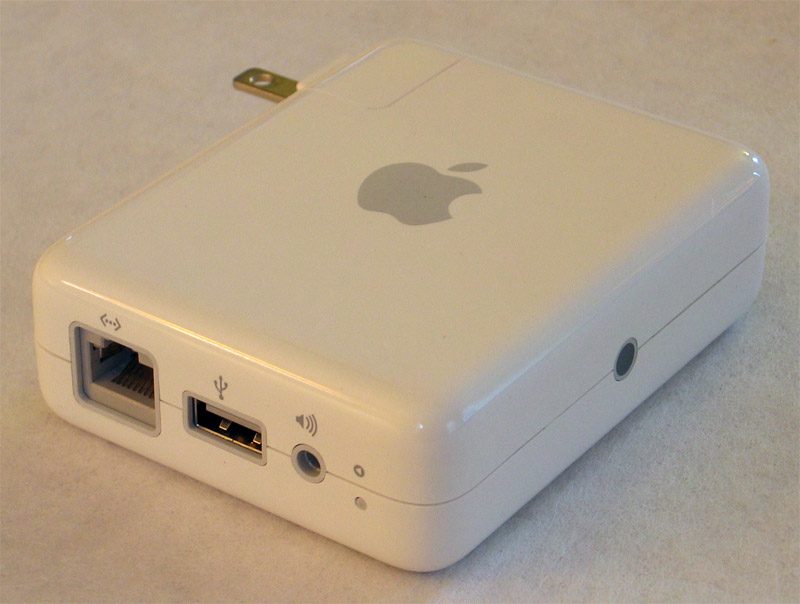
Recently I was re-architecting my home network. One of the main things I wanted to work with was whole-house audio. In two rooms of the house currently, we have Apple TVs hooked up – so I wanted to use an Airplay solution. However, I did not want to invest money into another Apple TV just yet – and at the same price is the Airport Express. Since I didn’t want to take a $99.00 per room hit I hit up E-Bay. Since this was going to be audio only (and I wanted to stay away from HDMI or optical cable solutions offered by the Apple TV) I wanted to pick up some older Airport Express access points. I figured this would be a cheap way to get the end result I was looking for. Since it was Apple, it should be a simple configuration right? Well……… not at all.
Over the course of a weekend, I managed to win 2 auctions totaling around 30.00 with shipping for 2 first gen a1084 Airport Express boxes. They arrived later that week, but I waited until they both came in before starting the configuration. I looked online and saw that you can configure the boxes from the Airport Express utility. I fired it up – and I received a message stating that it could find it, but that version could not be managed.
I looked online, it seems you need to track down an older version of the Airport Express utility (it can’t be newer than version 5.5.3). I then moved happily on my way thinking that this would be the only gotcha I would have. I logged in, configured the first unit, and checked airplay – nothing. The box would also not get the green light – only yellow. I reset the unit and tried again. It still had the same issue. I then went to a windows laptop – the same thing occurred. The device would not connect to the Wi-Fi network even though 802.11G was supported by one of the secondary channels in my router. This went on between the two devices about a dozen times. I was beginning to think this was a really bad idea. At least I was only out $30.00 – yet I refused to give up.
The first method I used was hooking up one of the units to an old Wi-Fi bridge I had. This gateway is older than the 9-year-old Airport Expresses – but always worked perfectly for me. This proved that I could get the unit to connect and Airplay music when it was connected to its ethernet port. This was at least progress, but since I only have one bridge – this would require another bridge purchase or running ethernet cables. Neither were things that I wanted to do. I worked on a hacked-up solution.
To the sunroom in my house, I ran an audio cable almost a decade ago. I went and checked and it was still there. The cable ran from the basement by the home router and a couple of systems I use for file sharing. It also is where the ethernet cables that are run terminate into gigabit switches. What I did next was hook one of the Airport Express points directly hardwired into the network. I then hooked up the audio cable to the device and some speakers – the audio was flowing. I could see it as an Airplay destination and music was controllable from my phone. Life was good. I only had one device to go.
The other device (and any future ones I may add) would not have the benefit of an audio cable or ethernet cable run. To alleviate this I created a new Wi-Fi network on the devices themselves. I figured that while they were choking trying to talk to a modern router – they should know enough to talk to one another. I was right. I made the SSID for this network hidden, solely because I didn’t want to have visitors attempting to connect to it. There wasn’t a security reason for this, just to simplify the visible airwaves (believing in security through obscurity is no security at all). They were connecting and talking. I could now Airplay to both devices. Life is good.
Since the only thing this new Wi-Fi network will ever handle is broadcast traffic from the LAN and Airplay traffic, the older speeds should be fine. I will likely purchase another 3-4 of these devices for various locations throughout the house. This should allow me to have an ok full-house audio deployment without investing like the SONOS. Before moving the Airport Express solution I attempted to make an Airplay destination out of a Raspberry Pi – the audio was too choppy to really be playable. I wish that solution had worked – but it is what it is. I can buy updated versions of the Pi, but that cost would likely be larger than used Airport Expresses.
Hopefully, this article helps someone from spending days trying to make this work with limited frustrations. It wasn’t fun – but it’s cheap and working.







